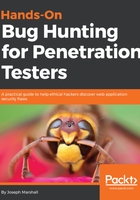
What You Will Learn – Next Steps
In addition to becoming familiar with these tools (and more) by the end of this book, you will also learn how to look for, successfully detect, and write a bug submission report for vulnerabilities associated with XSS, SQLi and NoSQLi, CSRF, XEE, data leakage, insecure session management, and unvalidated redirects, as well as framework and language-specific vulnerabilities, including sites powered by WordPress, Django, and Ruby on Rails applications. You'll also learn how to write a report that maximizes your payout, where to direct your attention to maximize your chances of finding a vulnerability, what vulnerabilities don't lead to payouts, preparing for your pentesting sessions, how to stay within the rules of engagement for a session, and other general tips for being productive – and profitable – as an independent security researcher participating in bug bounty programs.
Getting actual experience with penetration testing for the purpose of participating in a bug bounty program is key. You'll ultimately learn the most from taking the tools explored here and applying them to your own targets, so as you work through the book, you're encouraged to sign up with a third-party community and start your first forays into security research. As long as you adhere to the rules of engagement and are respectful of the app and its users, you can start trying out the techniques explored in these pages. Participating in forum discussions, reading about other users' experiences, following blogs, and generally being a part of the security community can also help you get a sense of effective strategies. Reading bug report submissions from other researchers who have gotten the OK to disclose their findings is a fantastic way to start understanding what makes a submission report effective and what vulnerabilities are typically discovered where.